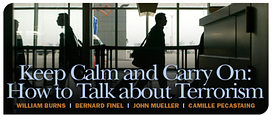Editors’ Note: From time to time, we receive particularly well-considered expert commentary on an issue of Cato Unbound. This month we received two such commentaries, and we are pleased to run the second of them today. It comes from Timothy Sellnow, a professor of risk and crisis communication at the University of Kentucky who has often worked with the U.S. Department of Homeland Security. Prof. Sellnow writes,
As a professor of risk and crisis communication who has worked closely with the Department of Homeland security on terrorism and public communication issues, I commend William Burns for his compelling overview of challenges and opportunities we face regarding terrorism — “the new species of trouble.” As a communication specialist, I was particularly impressed with Burns’ emphasis on dialog and resilience. Considerable communication research suggests that a genuine dialog — listening to public concerns and responding openly and accurately — between government agencies and the general public creates enhanced perceptions of self-efficacy and optimism. As Burns indicates, risk communication scholars have studied numerous crises in an attempt to generate “best practices for risk and crisis communication.” These best practices are split into three areas:
–pre-crisis dialog with all stakeholders, including the general public, that can help to avert or minimize the impact of a potential crisis,
–communication during a crisis that can help mitigate the impact of the crisis, and
–post-crisis communication that help to restore confidence and coordinate a response to the crisis
Burns is also correct in his emphasis of the need for message sensitivity in a dialog related to terrorism. Research indicates that standard media sources, for example, tend to miss underrepresented populations, particularly new Americans. This research consistently reveals that many individuals outside the mainstream population are less likely to trust standard information sources unless someone they trust has endorsed the message.
Burns’ call for a dialog that creates a realistic understanding of the actual risk and that empowers all stakeholders with the knowledge needed to function before, during, and after a crisis, is supported by an abundance of evidence. Indeed, such planning helps stakeholders accept and manage the uncertainty that is inherent in terrorism.
Additional work has been done to assess the degree to which the media accurately portrays the risk of terrorism. The results of this research are shared frequently with various media groups in hopes of creating opportunities for a synergistic relationship that makes coverage of such issues as bioterrorism as accurate as possible. If this effort is successful, two outcomes will occur:
–The media will reach its full potential to serve as a resource for improving the public’s understanding of risk in complex and evolving issues such as terrorism.
–The media will reflect both public concern and the realistic risk level of the terrorism threat.
Indeed this is the stated research and training objective of the risk communication team at one of the Department of Homeland Security’s Centers of Excellence.
Without a focus on improving relationships with the media, agency leaders miss an opportunity to create the accurate perception of terrorism, the “learned optimism” that Burns correctly contrasts with the problems of “learned helplessness.”
Burns’ essay and this response have addressed only a portion of the research being done in risk communication. Still, the call for an ongoing dialog that encompasses pre-crisis planning, crisis response strategies, and post-crisis needs is essential. The outcome of this dialog is a better-informed and more resilient population. Conversely, the absence of this commitment to dialog is likely to create an increasingly fearful society that lacks a capacity to allocate resources in a manner that accurately addresses the risk of terrorism.

